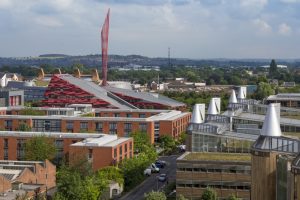August 24, 2020, by sustainablenottingham
We often talk about things being controlled by the BMS, but what actually is a BMS?
Building Management Systems (BMS), were first introduced in the 1980’s with the advent of the personal computer. By linking to inputs (sensors measuring temperature etc) and outputs (boilers, pumps, fans etc), it was possible for the first time to control the conditions in a building from another location.

There are over two hundred buildings across our UK campuses, each with at least one BMS panel.
The University first installed a Transmitton system in the early 1980’s. Since then the technology and capability has developed and the University has continued to invest in its systems. Today the scale of the University’s BMS is vast, one of the biggest within the sector, with over 200 buildings on our campus that each have at least one BMS panel with thousands of sensors across our buildings measuring all sorts of aspects.
Our BMS has a range of functionality including scheduling heating to come on at a set time and has optimum start functionality in that it reads the external temperature and makes a calculation of what time the boilers need to come on to bring buildings up to temperature by a set time. Below are some examples of how the system helps to control our internal environments.
In many spaces the BMS monitors carbon dioxide (CO2) levels. As the numbers of people in a space increases the amount of CO2 present will increase. High CO2 levels can cause fatigue and far more serious health complications if overlooked. Sensing this increased level the BMS reacts by increasing the volumes of fresh air supplier or by brining into use extractor fans.

BMS are set up differently for laboratory environments, to ensure safe working conditions.
The system also plays a critical part within laboratory environments, which we have many of here at Nottingham. Due to the nature of use, safety (chemicals, toxins, infectious diseases etc) is the first priority and the BMS supports this by ensuring consistent and sufficient air flow at all times to protect staff/students whilst at the same time, preventing any emissions escaping to other areas within and out of the building. This is done by extracting air via fume cupboards and fume cabinets, in addition to the usual extractor. The BMS balances the volume of air extracted from the standard extractor relative to the number of active fume cabinets in order to keep users safe.
Building Management Systems are an important part of University operations, ensuring that we have a comfortable and safe environment to work and learn. They have an important role to play as we return to campus, in properly ventilating rooms and helping us reduce our energy footprint.
In addition to the energy management and building comfort advantage mentioned above, the BMS also has major benefits for the operation of the University’s estate. It allows maintenance engineers to view the operation of complex plant as a whole, and to determine where work is needed. The system is programmed to generate alarms automatically on critical plant should there be a serious problem.
So next time BMS is discussed, you might be a little clearer on what it actually is!
No comments yet, fill out a comment to be the first

Leave a Reply